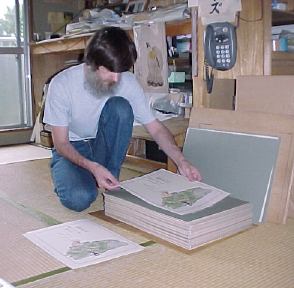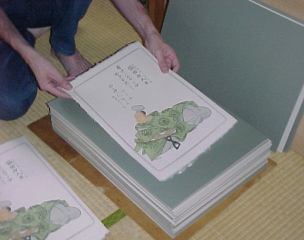Drying Prints - (entry by David Bull)
Drying prints is not difficult, but can be a time-consuming process, especially in the rainy season! When dealing with washi (Japanese papers), there are a few important points to observe:
- It is best not to start drying the paper immediately after printing the final colour impression. Give the pigment time to 'settle' into place. Wait at least a few hours - overnight is best.
- After the days and days of printing, the paper will by now be very soft and fragile. Handle it with great care, as any kinks or creases made at this point will be extremely difficult, if not impossible, to remove.
- Most prints made on washi, with the exception of those in which pigment has been deeply pressed into the entire surface of the sheet, will still have some 'body' or thickness at this stage in the process. Using a strong press to dry and flatten them can damage this, and can also damage any embossings that may be present. Heavy weights are not used.
Professional printers here in Tokyo nearly all dry their prints in exactly the same way. They have on hand a stack of cardboard, quite heavy stuff about 3mm thick, and about 1 metre square. (Note that this is not corrugated cardboard; using this will leave striations in the prints.)
The wet prints are laid out side-by-side (never overlapping) on a sheet of this cardboard, and another sheet is placed on top. More prints are laid out, another sheet placed on, and a large stack built up. A piece of plywood goes over the top, and maybe a few books or something to hold everything in place. How long they stay in there depends completely on the weather; it may be anywhere from a few hours, to some days ...
After the prints are removed, the cardboard is arrayed out on the balcony to dry out ready to be used again.
There are two problems with this procedure however, that lead me to use a different method for my own prints:
- Because the cardboard itself is carelessly dried out while hanging around out there on the balcony, it develops considerable warping. This is 'incurable', and each time prints are dried in it, they too pick up these warps. The stacks of prints that these men send off to the publishers are actually not very neatly pressed. I've heard considerable grumbling from publishers who have to spend a lot of time pressing them flat into a state suitable for selling.
- Where does the water go? The water isn't actually taken away from the stack. Most of it is absorbed by the cardboard, because that is thicker and heavier than the printing paper, but it doesn't go anywhere, and the prints remain still slightly damp when they are removed.
So I do things a bit differently. After printing the final colour, I give my workshop a complete once-over - cleaning up all the printing tools, and vacuuming the tatami mats thoroughly. When I am ready to start drying the prints I lay them out on the mats side-by-side, usually about 20 or so at a time, crack the windows and doors open, and then sit and watch them. How long this step takes again depends very much on the weather, and may take just a few minutes, or a few tens of minutes, but as soon as I see and feel that most of the moisture has 'flown out', but before they start to crinkle up, I quickly slide them into place in a stack of medium-weight illustration boards - two prints between each two boards.

Once the twenty sheets are in there, a piece of plywood and a couple of books go on top, and I lay out the next batch. This continues until they are all in there, and that is where they stay overnight. Come the next morning, they are wonderfully dry, extremely flat, and ready to be checked, signed, and sent out to my waiting collectors.

Because most of the moisture was allowed to escape before the prints went into the stack, the illustration boards themselves do not absorb a lot of water, and are thus not damaged and warped when I them put them out on the balcony to air out. I make sure that they are thoroughly dry, and then store them in the closet. I have been using the same set of 100 boards now for a couple of years, and they still show no warping, nor any sign of becoming moldy or otherwise unuseable.
I should mention that there are a couple of possible trouble spots with this method:
- Too much handling of the prints while they are so soft and wet is not good. If one is not extremely careful while laying them out on the mats and picking them up again, it is easy to make kinks or creases. I trust this job to nobody but myself.
- You have to be careful not to get interrupted. If you have to go away to answer the door, and get kept there by an important visitor, you will return to find that batch of prints all curled up and wrinkled. This isn't permanent damage, but these prints then have to be re-moistened with a brush (from the back side), left to settle, and then re-dried.
- And I could tell you some stories about an extremely curious and rather determined cat ... But perhaps that is better left to your imagination ...